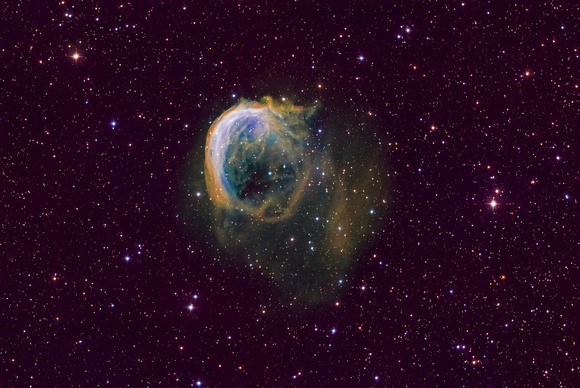The Shrimp Nebula – A PN in a Headwind
SH2-188 The Shrimp Planetary Nebula (Cassiopia) in SHO (Hubble palette) with RGB stars
Planewave CDK12.5; AP 1100GTO AE
ASI6200MM, - Antlia Pro RGB & 3.5nm NB filters
Ha/O/S: (44,37,36 x 540s exposures, Bin 1x1, Gain 200)
R,G,B: (24,24,24 x 120s, Bin 1x1, Gain 200)
Total Integration Time = 19.6 hours – August 2023
SH2-188 is a planetary Nebula in Cassiopeia first discovered in 1951. Visually, it appears as a crescent and was initially believed to be a super-nova remnant. Under narrowband imaging however, we can see that the nebula is roughly spherical, but gasses that comprise the nebula are being eroded on the (right/west and bottom/south) edges of the PN. This is due to the relative motion of the planetary nebula with respect to the interstellar medium - amounting to about 450,000 km/h! It is good for the PN that the interstellar media is very thin, but the effective wind is taking its toll, The components that once comprised the right and bottom sides – what must be the trailing edge, can now be seen joining the interstellar medium. On the bright side, the shells are likely being compressed, with the effective wind pushing from the left countering the UV support from the centre of the PN offered by the white dwarf progenitor star. Your guess is as good as mine which star that is.
The Shrimp Nebula is only 850 light years away and is larger than most PN at 10 arc-mins diameter – 1/3 the size of the moon.
In addition to Sh2-188, there appears to be another, very small PN or "hydrogen star" or extremely red star in the image, but this was not found in the catalogues. There are also a couple of galaxies absent/dim as NB didn't pick these up very well and were left out of the RGB stars transferred.


